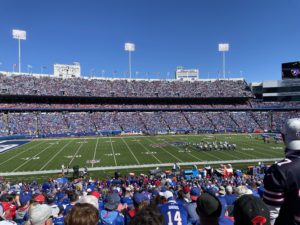Author: Rocco Termini
This article is not to suggest where the new Buffalo Bills stadium should go, but rather give facts that I think may have been overlooked and should be considered before a decision is made.
First, remodeling the existing stadium has been taken off the table. Some of the reasons are the expense and logistics of a remodeled stadium. But a remodeled stadium may be the least expensive in actual dollars.
I am assuming that the existing stadium would qualify to be on the National Register of Historic Places. The stadium was determined in 2017 to be ineligible, but with community support, I think the state historic preservation office can be convinced the building is eligible.
The Caesars Superdome in New Orleans and the Houston Astrodome were recently put on the National Historic Register. Let’s assume we can get the state to waive the tax credit cap.
Of the $1 billion cost to remodel the stadium in Orchard Park, I estimate that $800 million would be spent within the historic structure.
The federal credit is 20% of qualified expenses ($160 million), which can be sold to a corporation for 90 cents on the dollar or $144 million.
The state has a cap of $5 million on its credit. We would ask the state to waive the cap so we can get $160 million in qualified basis for the state credit.
The state credits have a value of 70 cents on the dollar or $120 million, so combined it would raise $256 million in cash. If the state doesn’t waive the cap you would only raise $3.5 million from the state credits.
Let’s assume the parking lot that has had cars leaking oil on it for 50 years would qualify for Brownfield tax credits, which could raise another $50 million in cash. Assuming it cost $800 million to renovate and the Pegulas contribute $40 million, the subsidy would be about $454 million.
Downtown: A downtown stadium at the Buffalo Municipal Housing Authority site and surrounding area would reportedly cost about $2 billion. One of the reasons for the extra expense for this site is the NFL’s new security buffer requirement around the stadium. Is this necessary, or can we ask for a waiver? Can our elevated highway act as a buffer? Why does it have to be vacant land?
Let’s assume we add a convention center to the site, which adds another $500 million. We now have a cost of $2.5 billion. A convention center on this site would make better use of the parking garages that would have to be built. If the project was leased to a for-profit limited liability corporation, the accelerated depreciation that the county can’t take could be monetized.
Given a 21% tax rate and $1.3 billion in qualified basis, this would create $400 million in project equity.
Given a 21% tax rate and $1.3 billion in qualified basis, this would create $400 million in project equity. The lease would have to be for 40 years and could have a put (HAVE A “PUT”??) after 10 years for a nominal fee. The ownership would revert to the county.
The site would qualify for Brownfield tax credits and if the state lifted the cap, would produce about $500 million in equity. This site also would have the potential to spur additional future development in the area such as hotels, casinos and restaurants, as a few examples.
If the Pegulas invested $70 million in this project, the total cost of the subsidy would be $1.53 billion. Don’t forget, this includes a convention center and a facility that could produce revenue for more than eight days out of the year.
A new stadium built in Orchard Park is projected to cost $1.5 billion. This would not be eligible for Brownfield credits or historic register credits but would be able to monetize the accelerated depreciation which could raise about $160 million. If the Pegulas invested $60 million, that would leave a subsidy of about $1.28 billion.
If you look at all the scenarios, the most expensive project is a new Orchard Park stadium. You decide what we should do.
www.change.org/BringTheBillsBackToTheCity
Rocco Termini is a Buffalo real estate developer.

